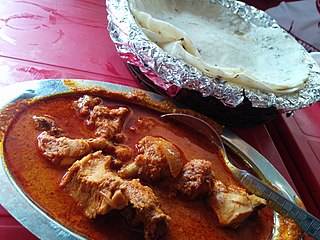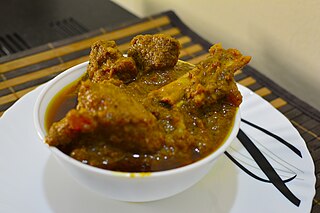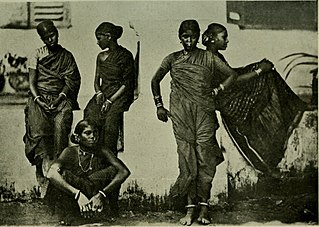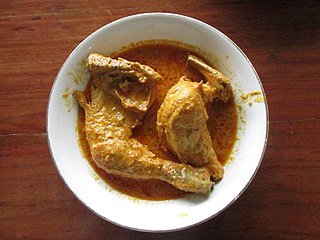| Place of origin | India Malaysia Singapore |
|---|---|
| Main ingredients | Rice, spices, chicken, mutton, seafood, and sometimes wild boar or monitor lizard |
Satti sorru also known as Indian claypot rice, is a dish common in the Indian communities of India, Malaysia, Indonesia and Singapore. [1] [2] Satti soru, which means 'clay pot rice' in Tamil, is a fairly common dish in South Indian households. Gravy from a curry is mixed into rice, to clean out the pan or the wok the curry was cooked in.
It is typically prepared by cooking rice along with various ingredients in a clay pot over a low fire or stove. The cooking pots are called man panai or man satti in Tamil, The clay pot helps retain moisture and infuse the rice with a unique aroma. Common ingredients include rice, spices, vegetables, meat, seafood and sometimes exotic meat such as monitor lizard and wild boar. [3] Spices commonly used in the dish may include cumin, coriander, turmeric, cinnamon, cardamom, and cloves.

Curry is a dish with a sauce seasoned with spices, mainly associated with South Asian cuisine. It is not to be confused with leaves from the curry tree, though some curries do include curry leaves. Curry is also found in the native cuisines of many South East Asian and East Asian countries due to ancient contact with South Asia.

Malaysian cuisine consists of cooking traditions and practices found in Malaysia, and reflects the multi-ethnic makeup of its population. The vast majority of Malaysia's population can roughly be divided among three major ethnic groups: Malays, Chinese and Indians. The remainder consists of the indigenous peoples of Sabah and Sarawak in East Malaysia, the Orang Asli of Peninsular Malaysia, the Peranakan and Eurasian creole communities, as well as a significant number of foreign workers and expatriates.

Indonesian cuisine is a collection of various regional culinary traditions that formed in the archipelagic nation of Indonesia. There are a wide variety of recipes and cuisines in part because Indonesia is composed of approximately 6,000 populated islands of the total 17,508 in the world's largest archipelago, with more than 1,300 ethnic groups.

Malay cuisine is the traditional food of the ethnic Malays of Southeast Asia, residing in modern-day Malaysia, Indonesia, Singapore, Brunei, Southern Thailand and the Philippines as well as Cocos Islands, Christmas Island, Sri Lanka and South Africa.

Fried rice is a dish of cooked rice that has been stir-fried in a wok or a frying pan and is usually mixed with other ingredients such as eggs, vegetables, seafood, or meat. It is often eaten by itself or as an accompaniment to another dish. Fried rice is a popular component of East Asian, Southeast Asian and certain South Asian cuisines, as well as a staple national dish of Indonesia. As a homemade dish, fried rice is typically made with ingredients left over from other dishes, leading to countless variations. Fried rice first developed during the Sui Dynasty in China.

Biryani is a mixed rice dish, mainly popular in South Asia. It is made with rice, some type of meat and spices. To cater to vegetarians, in some cases, it is prepared by substituting vegetables for the meat. Sometimes eggs and/or potatoes are also added.

Singaporean cuisine is derived from several ethnic groups in Singapore and has developed through centuries of political, economic, and social changes in the cosmopolitan city-state.

Motabbaq is a stuffed pancake or pan-fried bread which is commonly found in the Arabian Peninsula, the Indian subcontinent and Southeast Asia, notably in Saudi Arabia, Yemen, Indonesia, Malaysia, Singapore, Brunei and Southern Thailand. Depending on the location, the name and ingredients can significantly vary. The name mutabbaq in Arabic means "folded". It is a popular street food in Yemen, Indonesia, Malaysia, Thailand and Singapore.

Penang cuisine is the cuisine of the multicultural society of Penang, Malaysia. Most of these cuisine are sold at road-side stalls, known as "hawker food" and colloquially as "muckan carts". Local Penangites typically find these hawker fares cheaper and easier to eat out at due to the ubiquitousness of the hawker stalls and that they are open for much of the day and night. Penang island. On February 22, 2013, Penang was ranked by CNN Travel as one of the top ten street food cities in Asia. Penang has also been voted by Lonely Planet as the top culinary destination in 2014.

Claypot rice, sometimes translated as "rice casserole", is a Chinese traditional dinner eaten widely in Guangdong in Southern China as well as the Chinese communities of Malaysia, Indonesia, Singapore and Thailand.

Indian Chinese cuisine, Chinese Indian cuisine, Sino-Indian cuisine, Chindian cuisine, Hakka Chinese or Desi-Chinese cuisine is a distinct style of Chinese cuisine adapted to Indian tastes, combining Chinese foods with Indian flavours and spices. Though Asian cuisines have mixed throughout history throughout Asia, the most popular origin story of the fusion food resides with Chinese labourers of Calcutta, who immigrated to British Raj India looking for work. Opening restaurant businesses in the area, these early Chinese food sellers adapted their culinary styles to suit Indian tastes.

Chicken curry or curry/curriedchicken is a South Asian dish originating from India. It is common in the Indian subcontinent, Caribbean, Arabian Peninsula, Southeast Asia, Great Britain, and Japan. A typical curry from the Indian subcontinent consists of chicken stewed in an onion- and tomato-based sauce, flavoured with ginger, garlic, tomato puree, chilli peppers and a variety of spices, often including turmeric, cumin, coriander, cinnamon, and cardamom. Outside of South Asia, chicken curry is often made with a pre-made spice mixture known as curry powder.

Indian Singaporean cuisine refers to food and beverages produced and consumed in Singapore that are derived, wholly or in part, from South Asian culinary traditions. The great variety of Singapore food includes Indian food, which tends to be Tamil cuisine and especially local Tamil Muslim cuisine, although North Indian food has become more visible recently. Indian dishes have become modified to different degrees, after years of contact with other Singapore cultures, and in response to locally available ingredients as well as changing local tastes. The local forms of Indian food may be seen as localised or even regional variations of Indian food, or in some cases, a form of hybrid Indian-Singaporean cuisine. Popular 'Indian' dishes and elements of Indian cuisine include:

Malaysian Indian cuisine, or the cooking of the ethnic Indian communities in Malaysia, consists of adaptations of authentic dishes from India, as well as original creations inspired by the diverse food culture of Malaysia. Because the vast majority of Malaysia's Indian community are of South Indian descent, and are mostly ethnic Tamils who are descendants of immigrants from a historical region which consists of the modern Indian state of Tamil Nadu and Sri Lanka's Northern Province, much of Malaysian Indian cuisine is predominantly South Indian inspired in character and taste. A typical Malaysian Indian dish is likely to be redolent with curry leaves, whole and powdered spice, and contains fresh coconut in various forms. Ghee is still widely used for cooking, although vegetable oils and refined palm oils are now commonplace in home kitchens. Before a meal it is customary to wash hands as cutlery is often not used while eating, with the exception of a serving spoon for each respective dish.

Mutton curry is a dish that is prepared from goat meat and vegetables. The dish is found in different variations across all states, countries and regions of the Indian subcontinent and the Caribbean.

Penangite Indians, also known as Chulias, are Malaysian Indians that live primarily in the state of Penang, Malaysia. Most are the descendants from those who migrated from India during the British colonisation of Malaya. However, historical sources prove that the ancient Indians arrived in Penang during the Chola dynasty. Penangite Indians forms a large percentage of the state's professional community such as business, law and medicine as well as politics, it can be proven by the appointment of Dr. P. Ramasamy as deputy chief minister of Penang. It made him the first Malaysian of Indian origin to hold the post of deputy chief minister in any state of Malaysia. In addition, first Tamil Vernacular School in Malaysia was established in Penang.

Gulai is a class of spicy and rich stew commonly found in Indonesia, Malaysia and Singapore. The main ingredients of this dish are usually poultry, goat meat, beef, mutton, various kinds of offal, fish and seafood, as well as vegetables such as cassava leaves, unripe jackfruit and banana stem.

Indian Indonesian cuisine is characterized by the mixture of Indian cuisine with local Indonesian-style. This cuisine consists of adaptations of authentic dishes from India, as well as original creations inspired by the diverse food culture of Indonesia. Indian influence can be observed in Indonesia as early as the 4th century. Following the spread of Islam to Indonesia and trading, Muslim Indian as well as Arab influences made their way into Indonesian cuisine. Examples include Indian biryani, murtabak, curry and paratha that influenced Acehnese, Minangkabau, Malay, Palembangese, Betawi and Javanese cuisine.